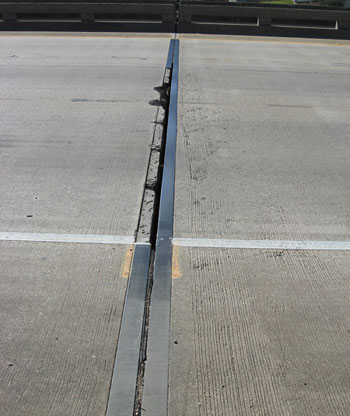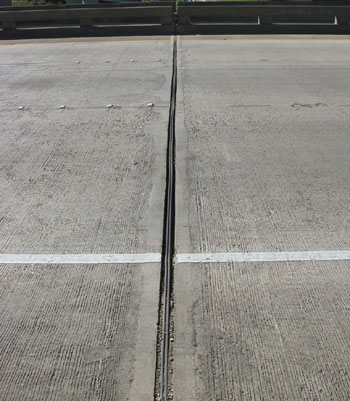U.S. Department of Transportation
Federal Highway Administration
1200 New Jersey Avenue, SE
Washington, DC 20590
202-366-4000
Focus
| Accelerating Infrastructure Innovations |
Publication Number: FHWA-HRT-09-013
Date: May 2009
New bridge preservation initiatives nationwide are advancing efforts to enhance bridge performance, deter or correct deterioration, extend service life, and increase safety. The goal of a bridge preservation program is to increase the service life of a bridge using cost-effective, timely strategies, without having to reconstruct it. "With today's aging bridges and budgets that cannot keep up with demands, bridge preservation is a key component in maintaining and preserving the Nation's transportation infrastructure," says Ken Jacoby of the Federal Highway Administration (FHWA).
The Safe, Accountable, Flexible, Efficient Transportation Equity Act: A Legacy for Users (SAFETEA-LU) Technical Corrections Act, enacted June 6, 2008, changed the Federal Highway Bridge Replacement and Rehabilitation Program to the Highway Bridge Program and placed greater emphasis on the importance of proper, timely bridge preservation. Highway Bridge Program funds can now be used for replacement, rehabilitation, painting, performing systematic preventive maintenance, seismic retrofitting, or applying anti-icing or deicing treatments to eligible highway bridge projects.
| "Bridge preservation is a key component in maintaining and preserving the Nation's transportation infrastructure." |
Bridge preservation initiatives underway include expansion of the Transportation System Preservation Technical Services Program (TSP·2) to include a new bridge preservation technical services component, including support of regional bridge preservation and maintenance partnerships.
TSP·2 was established in 2006 to serve as a clearinghouse for transportation system preservation technical information and expertise and to facilitate communication among transportation practitioners. The program is sponsored by the American Association of State Highway and Transportation Officials (AASHTO) and hosted by Michigan State University through a contract for the TSP·2 Center in Okemos, Michigan. The first phase of the AASHTO program focused on pavement preservation. In October 2008, AASHTO approved expansion of the program to include bridge preservation.
Online TSP·2 bridge preservation resources available at www.tsp2.org include a bridge news archive, library of technical documents, bulletin boards to post questions and comments, and information on regional bridge preservation partnership groups. Partnerships have been formed for the Northeast, Southeast, Midwest, Southwest, and Pacific Northwest regions, with a Rocky Mountain Group being planned as well. TSP·2 will also be expanded to provide a full line of services similar to those provided in the pavements area. AASHTO is developing a technical services contract to establish a bridge preservation help desk, for example, which transportation agencies can call or visit online for personalized technical assistance. Education, outreach, and other support services will also be provided.
The TSP·2 is supported by an AASHTO voluntary fund. Any AASHTO member can join the program. Membership costs $20,000 per agency per year, which includes both the bridge preservation and pavement preservation programs. These funds also cover the cost of travel to bridge preservation and pavement preservation partnership meetings for two State representatives. The TSP·2 will fully support meeting organization and facilitation costs. FHWA has approved a waiver of the non-Federal match for the use of State Planning and Research funds for TSP·2 contributions. For more information on TSP·2, visit www.tsp2.org.
 |
 |
| Louisiana's Bridge Preventive Maintenance Program includes such activities as bridge deck joint repair and replacement. At top is a bridge before joint replacement, while on the bottom is the new bridge deck joint. |
The TSP·2 activities support the goals of the AASHTO Highway Subcommittee on Maintenance's draft Bridge Preservation Strategic Plan. These goals include improving bridge preservation and maintenance practices, facilitating the exchange of technical information on state of the practice and new products and methods for bridge preservation and maintenance, assisting States in implementing bridge preservation and maintenance practices, supporting improvements to the knowledge base related to bridge preservation and maintenance, and developing partnerships among related transportation stakeholders. The TSP·2 activities also fully support the efforts of AASHTO's Bridge Preservation Committee under the AASHTO Subcommittee on Bridges and Structures.
Also building partnerships is the new Bridge Preservation Association (BPA), which will bring together both industry and transportation agency stakeholders to advance bridge preservation and maintenance practices, procedures, products, and technologies. "We want to encompass all aspects of the structure that can be maintained through preservation strategies, from the deck to the stream bed," says BPA President Tom Donnelly of Cargill SafeLane.
| Also building partnerships is the new Bridge Preservation Association (BPA), which will bring together both industry and transportation agency stakeholders to advance bridge preservation and maintenance practices, procedures, products, and technologies. |
The association plans to establish subcommittees to address specialized bridge areas, including corrosion protection, bearings, deck wearing surfaces, and foundations. "We will bring industry and agency experts together to work on key issues, evaluate technologies, and develop best practices and specifications," says Donnelly. "We hope to partner with and support the TSP·2 program, especially as it works with the regional bridge partnerships around the country." For more information on the BPA, visit www.bridgepreservationassociation.org.
FHWA is also looking at forming a Bridge Preservation Expert Task Group (BP ETG) later this year. The BP ETG would bring together representatives from States, industry, academia, and FHWA to work on bridge preservation initiatives. Focus will provide updates on the new ETG's activities as more information becomes available.
Also supporting the advancement of bridge preservation is FHWA's Transportation System Preservation Research, Development, and Implementation Roadmap, which outlines 38 pavement preservation and 25 bridge preservation need statements. Released in 2008, the roadmap was developed in partnership with industry, AASHTO, and the Transportation Research Board (TRB). Its need statements have been ranked and prioritized to facilitate their adoption into the short-term and long-term research funding programs of FHWA, TRB, and State transportation agencies. The top priorities for bridges include improving inspection techniques for steel prestressing strands, cables, and ropes; quantifying the information necessary to guide bridge preservation decisions; and identifying best practices to preserve bridge decks. For more information or to download a copy of the roadmap, visit www.tsp2.org.
States already moving forward with bridge preservation include Louisiana. The Louisiana Department of Transportation and Development (LADOTD) launched a Bridge Preventive Maintenance Program in 2006 (see June 2008 Focus). The program's goal is to apply a systematic procedure in choosing bridge structures for preventive maintenance activities that are in good overall condition but are exhibiting deficient bridge elements. The following preventive maintenance activities are approved under Louisiana's program:
LADOTD let three initial projects in June 2008, including a concrete deck overlay project on U.S. 90 in the New Orleans area; deck joint replacements on I-49, LA 1, and U.S. 71 in Alexandria; and deck spall repairs on I-10 near Henderson. Four additional projects have been let since then, with five more forthcoming. "The projects have gone really well to date. Our districts have all been very enthusiastic about the program," says program manager Danny Tullier of LADOTD. As a member of the steering group for the Southeast Bridge Preservation Partnership, Louisiana is sharing its experiences with other States.
As part of its Bridge Preventive Maintenance Program, LADOTD is in the process of implementing the Pontis® Bridge Management System. Originally developed by FHWA, Pontis is now available from AASHTO as an AASHTOWare® product. The software can be used to store highway bridge inventory and inspection data. It provides a systematic procedure for allocating resources to preserve and improve highway bridges by considering both the costs and benefits of maintenance policies versus investments in improvements or replacements. LADOTD expects to have Pontis fully implemented by summer 2010. To learn more about Louisiana's Bridge Preventive Maintenance Program, contact Danny Tullier at LADOTD, 225-379-1355 (email: Danny.Tullier@la.gov). For more information on Pontis, visit www.aashtoware.org (choose "Software" and then select "Pontis").
For more information on bridge preservation, contact your local FHWA division office; Ken Jacoby at FHWA, 202-366-6503 (email: ken.jacoby@fhwa.dot.gov); or Wade F. Casey at FHWA, 202-366-4606 (email: wade.casey@fhwa.dot.gov). Information is also available online at www.fhwa.dot.gov/preservation. To see the current FHWA guidance on using Federal-Aid Highway Bridge Program funds for preventive maintenance activities, visit www.fhwa.dot.gov/preservation/100804.cfm.
Online Bridge Preservation ResourcesTransportation System Preservation Technical Services Program - www.tsp2.org Bridge Preservation Association - www.bridgepreservationassociation.org FHWA - www.fhwa.dot.gov/preservation Pontis® Bridge Management System - www.aashtoware.org |